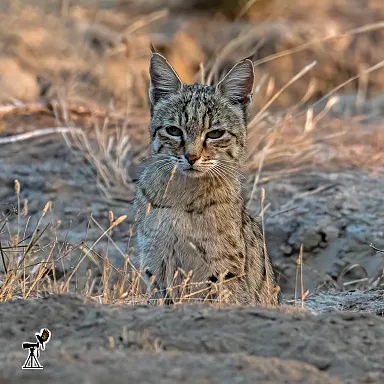
African-Asian Wildcat. Photo © Uday Agashe · some rights reserved
African-Asian Wildcat
Species Facts
The African-Asian wildcat resembles a domestic cat, though unlike the domestic cat, the wildcat has long, slender legs and a long, thin tail. In addition, the backs of the ears are characteristically a rich dark brown. The fur color and markings of the African-Asian wildcat are extremely variable, ranging from grayish to reddish, with or without spots.
- Scientific Designation: Felis silvestris lybica, Felis silvestris ornata
- Endangered Status: Least Concern (LC)
- Lifespan: Up to 15 years
- Weight: 4-6 kg (3-6.5 kg)
- Length: 45-75 cm
- Shoulder Height: 35 cm
- Tail Length: 20-38 cm
Profile
These cats are widely distributed throughout Africa and the Middle East. In keeping with its wide geographic distribution, the wildcat lives in a wide variety of habitats ranging in altitude from sea level to 3,000 meters. This cat requires cover for hunting and rest sites. Most hunting is conducted on the ground, but this wildcat can climb well when necessary. It feeds on small prey, such as arthropods and rodents, but occasionally takes larger animals, such as hares, rabbits, and young antelope. Little is known about the African-Asian cat’s social habits, but it is believed to be highly territorial.

African-Asian Wildcat. Photo taken at Lake Ndutu, Serengeti National Park, Tanzania, East Africa. © Allan Hopkins · some rights reserved
Species Distribution
With regard to the African-Asian wildcat’s status in the wild, no density estimates are available. However, given its flexible food habits, tolerance of a wide range of ecological conditions, and ability to survive near humans, the species is probably in no immediate danger in Africa. Interestingly, the African-Asian wildcats may, in fact, be one of the few species of cat to have benefited from human activities in Africa, since agricultural development has increased rodent densities.
By contrast, the Asian population’s status is rare and restricted in its distribution. This is due to the fact that it kills poultry and is frequently shot or trapped as a pest. Another threat to the African-Asian wildcat is the fact that it interbreeds freely with domestic cats. It is classified as Least Concern (LC ) by the International Union for Conservation of Nature (IUCN) and is protected under the Convention on International Trade in Endangered Species (CITES) appendix II.
Want to help us research and conserve this species?
Felidae Conservation Fund helps researchers around the world study and protect felids of all sizes.
Make sure you write a comment with "African-Asian Wildcat" so we can designate 100% of your donation to go to protecting this species.
Do You Have 2-4 Hours A Month To Preserve Your Local Ecosystem?
Our volunteers are the driving force behind making true change in ecosystem health and wild cat conservation. Some like to volunteer in the field, others help us maintain our online presence, and some work with events. With just a few hours a month, you can make a difference, too.
Make A Difference Right Now
As a 501(c)3 nonprofit, our work is only possible because of generous donors like you.
More than 90% of your donation will go directly to our groundbreaking research, outreach, and education programs.
This is where true change starts. If you’d like to be a part of it, make a donation to Felidae Conservation Fund today:
Or,
